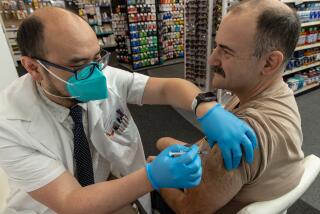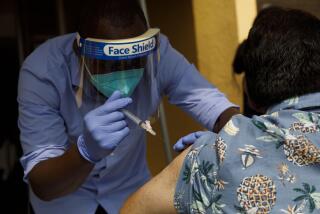Vaccine Surplus Is Flu Scare’s Ill Effect
After months of strictly limiting who can get a flu shot, public health officials in California are left with far more available vaccine than they expected and are urging more people to get inoculated before the medicine reaches the end of its shelf life.
Demand for the shots, which just a few months ago was so high that seniors citizens waited in line for hours, has dropped off significantly in recent weeks, prompting fears that private doctors and clinics will stop ordering the vaccine even though many people who got inoculated last year have not this year.
Of the 540,000 doses of vaccine set aside by the federal government for California doctors, physicians have ordered only 370,000. That leaves about 170,000 doses unclaimed, and officials say the vaccine is good only until the end of this flu season.
The drop in demand has surprised health officials, who until now had worried that they would have to turn away patients for lack of sufficient vaccine.
In response, the state has lowered its recommended age requirement for the inoculations from 65 to 50 and is trying to get the word out that there is vaccine available.
But the change in the age level has so far failed to bring the flood of interest that some officials expected.
Officials don’t think they will lower the age cutoff further, because younger people are at lower risk in general and there are still many older people who haven’t received shots.
Since the shortage began, some doctors have ignored the age limits and offered vaccine to all their patients.
About half the U.S. supply was cut off when contamination was discovered at the Chiron Corp. production plant in Liverpool, England.
Since then, U.S. officials have found and distributed alternative supplies from several sources, including French drug maker Aventis Pasteur Inc. and British company GlaxoSmithKline. Now, California and other states are left with the added supply but fewer and fewer takers.
Officials are battling a mind-set they helped create.
“Because of all the media coverage of the flu shortage, I think there were a lot of people who felt like they needed to defer their shot to others who were not as healthy even if they were in the high-risk category,” said Robert Schechter, co-chairman of the California Department of Health Services’ immunization branch.
Another reason so much vaccine is going unused is that, so far, the flu season has been relatively mild, leaving people less inclined to get a last-minute immunization.
Flu season usually peaks in mid-January, but Schechter said there were still several weeks left during which the vaccine would be effective. Despite the slow start, he said, a significant flu outbreak could still occur any time between January and March.
“People still have an opportunity to protect themselves,” he said. “It only takes one to two weeks after you’re vaccinated for the shot to provide full protection.”
When the shortage first struck, health officials focused on getting the vaccine to patients who faced life-threatening complications if they contracted the flu. Local health departments held clinics for senior citizens and provided the vaccine to hundreds of nursing homes.
The U.S. Centers for Disease Control and Prevention estimates that 40% to 49% of the 10 million Californians at high risk have received the shot this year. Health officials believe that is about the same figure as last year.
With few patients clamoring for the vaccine, doctors are faced with the tough choice of whether to purchase more. Each dose costs about $8, and the vaccine cannot be returned.
Scientists develop a new flu vaccine each year to combat the most prevalent strains, so this year’s medicine cannot be used next winter, said Dr. Jonathan Fielding, Los Angeles County’s public health director.
“The problem for private providers is buying vaccine upfront,” he said. “They don’t know what proportion of the population has gotten it elsewhere already, so they don’t know how many people will come forward seeking a shot.”
Schechter urged private doctors to continue ordering the vaccine. He said that although demand for the shots typically dipped during the Christmas season, it sometimes picked up in early January. “As community practitioners, it’s important that they get as many people protected as possible,” he said.
But physicians said there was little point in stockpiling the drug if they had already vaccinated their high-risk patients.
“It’s like the Beanie Baby phenomenon: Scarcity drives demand,” said Sam Fink, an internist in Tarzana who received a batch of vaccine last week from the state.
Fink ordered 50 shots’ worth this year, 150 less than he did last year. He believes he can cover all his high-risk patients, with a few doses left for anyone ages 50 to 65 who wants a shot. But he is less concerned about these younger patients getting the vaccine, because they are much less likely to become seriously ill from the flu than senior citizens.
“I wouldn’t put a 50-year-old in the same category as a 90-year-old,” Fink said. “There’s a big difference between the two.”
Margaret Colvin, 58, of Riverside had assumed she would forgo a flu shot this year because she believed there were people who needed it more than she. But with the state dropping the age limit, she plans to be inoculated as soon as she is over a cold.
Colvin’s husband, 81, got the shot a few months ago. But because she didn’t, she worried that she could get the flu bug and pass it on to him. The couple have been taking extra precautions this winter, such as eating at restaurants less often and taking vitamin C.
With health officials now saying demand for shots from high-risk patients is down, she feels fine about getting a shot herself.
“We were glad they were strict with it rather than leaning the other way,” she said. “We wouldn’t want people in the prime of their lives getting [shots] and other people who need them not being able to.”
Kaiser Permanente led the charge to lower the age limit, opening its clinics up to 50- to 65-year-olds several days before the state did.
Kaiser officials said that despite the extra supply, they expected to give far fewer flu shots this year than last. Kaiser has immunized 425,000 people so far in Southern California this year, compared with 700,000 for the previous flu season.
“People need to remember that even though supply seems to be high, no one really has as much vaccine as they need to vaccinate everyone,” said Kaiser spokesman Jim Anderson. “As soon as the flu hits, you’ll see people coming to get the vaccine.”
More to Read
Sign up for Essential California
The most important California stories and recommendations in your inbox every morning.
You may occasionally receive promotional content from the Los Angeles Times.











